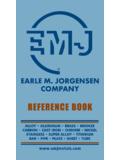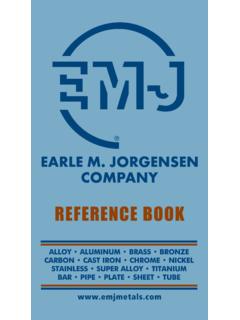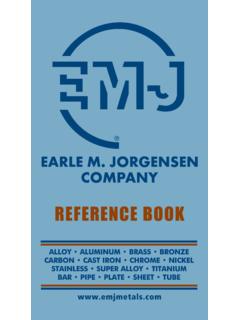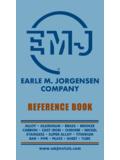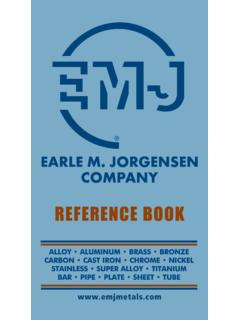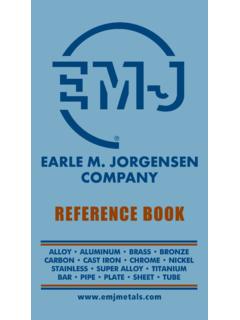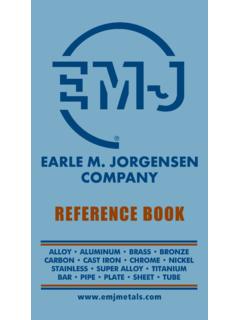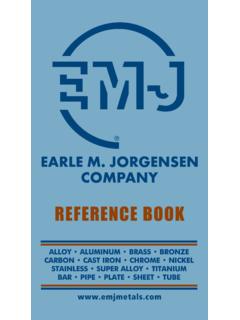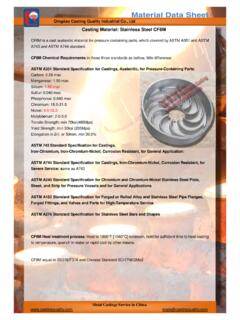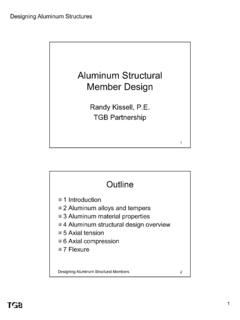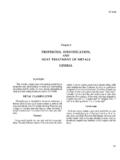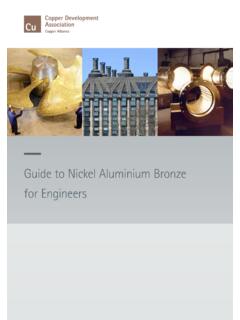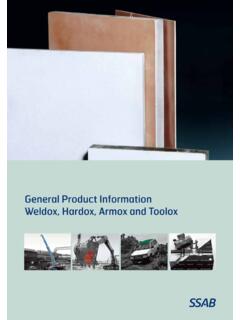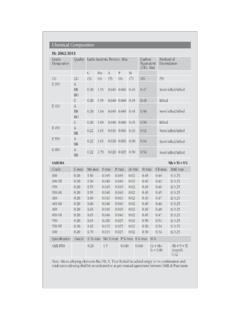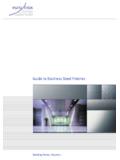Transcription of Section F - EMJ
1 FSection FHiGH StRenGtH LoW ALLoY SteeLSHeAt tReAteD conStRUctionAL ALLoY SteeLSABRASion ReSiStinG SteeLSHiGH StRenGtH LoW ALLoY SteeLS ..2-3 Sheets and PlatesHeAt tReAteD conStRUctionAL ALLoY SteeLS ..4-5 PlatesAR 235 ABRASion ReSiStinG SteeL ..6 Plates and SheetsAR 360 ABRASion ReSiStinG SteeLS ..7 PlatesAR 400 ABRASion ReSiStinG SteeL ..8 PlatesABRASion ReSiStinG SHeetS ..9 Sheets and PlatesHiGH StRenGtH LoW ALLoY SteeLSSHeetS PLAteSHigh strength low alloy (HSLA) steels are essentially low carbon steels to which have been added small amounts of such alloying elements as chromium, nickel, molybdenum, vanadium, zirconium, copper, and columbium.
2 The effect of the alloy addition is to raise the yield point of the steel in the as-rolled condition to a level substantially higher than that of the structural carbon grades, and at the same time provide weldability and formability. Thus, they offer the advantages of higher strength-to-weight ratios, increased resistance to wear and abrasion, and in some cases improved resistance to atmospheric steels are produced under dozens of different trade names and are covered by a number to ASTM, SAE, and military specifications. General characteristics are similar, but the various grades may be categorized in a general way according to their resistance to atmospheric to Atmospheric corrosionequivalent to that of carbon Steelscolor Marking: Brown and Orange Specifications: ASTM A 572 Grade 50 (Plates) SAE J410 Grade 950X (Sheets, Plates)Resistance to Atmospheric corrosiontwo times that of carbon Steelscolor Marking: Red and White Specifications: ASTM A 606 Type 2 (Sheets) SAE J410 Grade 950B (Sheets, Plates)Resistance to Atmospheric corrosionFour times that of carbon Steelscolor Marking: Gold and Red Specifications.
3 ASTM A 242 Type 1 (Plates) A588 (Plates) A606 Type 4 (Sheets) SAE J410 Grade 950D (Sheets, Plates)MecHAnicAL PRoPeRtieS The following minimums generally apply depending upon applicable thickness and specification : Tensile Strength, min, psi 70,000 Yield Strength, min, psi 50,000 Elongation, min, % in 2 (Sheet) 22 % in 8 (Plate) 18 WeLDABiLitY High Strength Low Alloy grades are weldable with welding techniques suitable for the grade and intended . F Page 2 Sec . F Page 3 HiGH StRenGtH LoW ALLoY SteeL (Continued) HiGH HiGH StRenGtH StRenGtH SHeetS PLAteS Width est . Wt . Width est.
4 Wt . thick- and Lbs . Per thick- and Lbs . Per ness Length Sheet ness Length Sheetcold Rolled20 Ga . 1 .50 Lbs . Sq . Ft ..0359 36 x 120 Ga . 2 .0 Lbs . Sq . Ft ..0478 48x120 144 Ga . 2 .5 Lbs . Sq . Ft ..0598 36x120 48x120 144 Ga . 3 .125 Lbs . Sq . Ft ..0747 60x120 144 Rolled14 Ga . 3 .125 Lbs . Sq . Ft ..0747 36x120 120 144 48x96 120 144 240 Ga . 3 .75 Lbs . Sq . Ft ..0897 60x240 Ga . 4 .375 Lbs . Sq . Ft ..1046 36x120 48x96 120 144 192 240 60x96 120 144 192 240 Rolled12 Ga . (Cont.) 72x120 144 192 240 Ga.
5 5 .0 Lbs . Sq . Ft ..1196 48x120 144 192 240 60x144 192 240 72x120 144 192 240 Ga . 5 .625 Lbs . Sq . Ft ..1345 36x96 120 48x96 120 144 240 60x96 120 144 192 240 72x96 120 144 192 240 Ga . 7 .5 Lbs . Sq . Ft ..1793 48x120 144 192 240 StrengthLow AlloyPlatesare stocked inthicknessesfrom 3/16 to 3 1/2 ,widths up to 96 ,andlengths up to 360 .For weightsrefer toSection D,Pages 6 and . F Page 4 HeAt tReAteD conStRUctionAL ALLoY SteeLSPLAteS AStM A 514color Marking: Blue and BrownHeat Treated Constructional Alloy Steels are low carbon alloy steels that have been heat treated by conventional liquid quenching and tempering to a strength level substantially higher than that of the high strength low alloy grades.
6 The alloying elements and amount of alloy content vary among the grades depending upon the Section thickness and desired properties. The low carbon content improves their general specification A 514 covers this material in Structural Quality. The specifica-tion provides for a number of grades, which correspond to trade names of various steel AStM Grade F B H Q c c .10/.20 .12/.21 .14/.21 .10/.20 Mn .60 .70 .95 .95 P Max ..035 .035 .035 .035 .035 S Max ..040 .040 .040 .040 .040 Si .15/.35 .20/.35 .20/.35 .15/.35 .15/.30 cr .40/.65 .40/.65 .40/.65 ni .70 .30/.70 Mo .40/.60 .15/.25 .20/.
7 30 .40/.60 .20/.30 V .03/.08 .03/.08 .03/.08 .03/.08 ti .01/.03 cu .15/.50 B .0005/.006 .0005/.005 .0005/.005 .001/.005 APPLicAtionS Structural Quality is used in general structural applications where its greater strength permits reduction in weight by using smaller cross- sectional areas. It is intended for welded construction where welding procedures are suitable to maintain the properties of the plate. Such applications include bridge and building members, body and frame members for earth-moving and transportation equipment, and components for heavy tReAteD conStRUctionAL ALLoY SteeLS (Continued)MecHAnicAL PRoPeRtieS Applicable to Structural Quality.
8 Reduction of Area Min . elon- AStM Yield tensile gation over A 514 Strength Strength in 2 3/4 & 3/4 Grade thickness (psi) (psi) Min . Under thick Minimum B & c Up to 11/4 incl. 100,000 110/130,000 18% 40% 50% H Up to 2 incl. 100,000 110/130,000 18% 40% 50% F Up to 21/2 incl. 100,000 110/130,000 18% 40% 50% Q Up to 21/2 90,000 100/130,000 16% 50% 6 Structural Quality material is readily cold formed, provided sufficient power is available and allowance is made for greater spring back than with mild steel. thickness of material Minimum Radius Up to 1 incl.
9 2 x thickness Over 1 to 2 incl. 3 x thickness Warm forming may be done at temperatures below 1100 F without destroying the mechanical properties or toughness. Hot forming may be done at 1600 - 1800 F, but the formed part must be heat treated to restore its original Cutting speed of Structural Quality is approximately 40% of that of 1212, or 65 surface feet per Techniques similar to those used in structural carbon steels apply, but precautions must be exercised. Hydrogen must be kept out of the welding operation. Large sections or those under high restraint should be preheated to temperatures not exceeding 400 tReAtinG Stress relieving may be performed, if necessary, by heating at temperatures up to 1100 F.
10 If Structural Quality material is heated over 1100 F, it must be re-heat treated to restore the original strength. Austenitize 1650 - 1700 F Quench Agitated Water Temper 1150 - 1250 FHeAt tReAteD conStRUctionAL ALLoY PLAteSStocK SiZeS Stocked in thicknesses from 3/16 to 6 and lengths up to 30 . Stock widths are 72 , 84 , or 96 , depending on weights, refer to Page 7 of Section . F Page 5 Sec . F Page 6AR 235 ABRASion ReSiStinG SteeLPlates Sheetscolor Marking: Gray and OrangeAbrasion Resisting Steel AR 235 is a medium-carbon, high-manganese, product. It is a hard, tough, wear-resistant steel which is ductile enough to permit certain chemical composition of this grade provides a Brinell hardness of approximately 235 in the as-rolled condition, along with a tensile strength of approximately 115,000 (Typical) carbon Manganese Phosphorus Sulphur Silicon.
